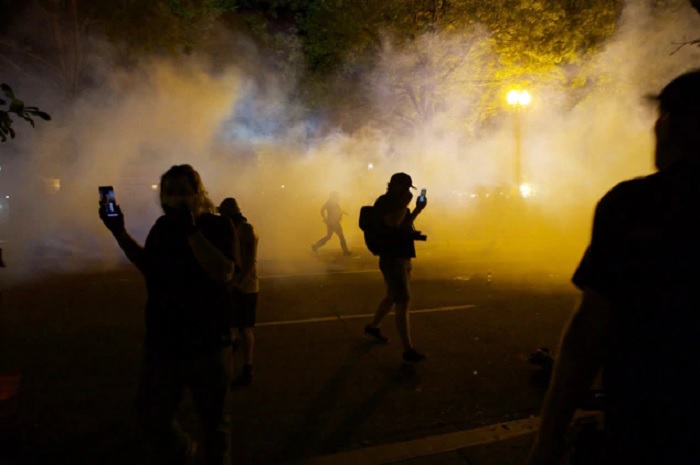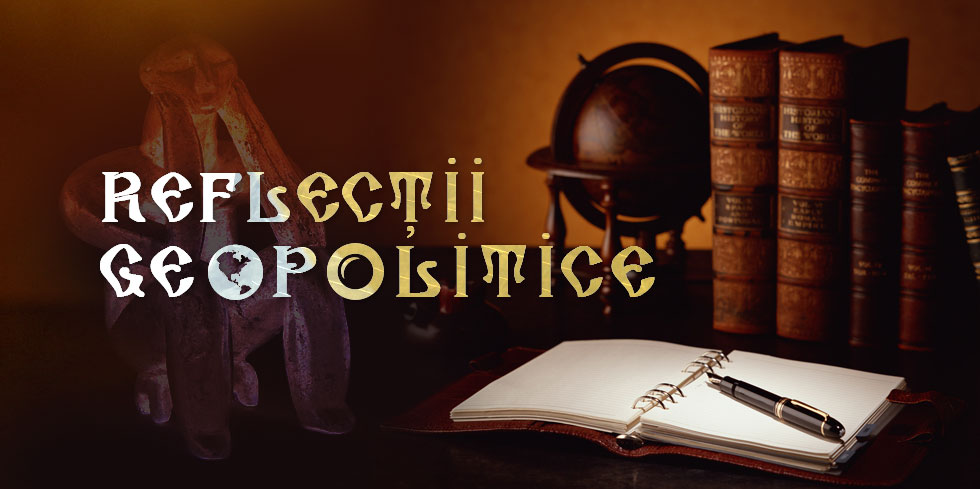
Why is Trump trying to designate it as a terrorist organization in the wake of protests over George Floyd’s death?
President Trump is blaming the far-left network known as antifa for the looting and rioting that has arisen during anti-police-brutality protests in cities across the nation. Trump said he’ll label the movement a terrorist organization, though he legally cannot do that, and Attorney General William P. Barr said there is evidence antifa and other similar extremist groups are instigating violence.
Experts who have studied antifa say there is no evidence that the fringe, amorphous group is driving nationwide protests, and Trump hasn’t cited anything specific as he accused them of doing so. Some experts worry Trump is conflating antifa with peaceful protesters in a dangerous way for democracy.
But even as the protests have been overwhelmingly peaceful in recent days, Trump and Barr have made a concerted effort to implicate antifa involvement in them. On Tuesday, Trump tweeted a baseless conspiracy theory that a 75-year-old man who was shoved and injured by police in Buffalo was actually faking part of his fall becuse he’s antifa, the reason being the man was holding a phone as he approached police.
When asked on Fox News on Monday why no arrest records so far talk about antifa, Barr said the Justice Department is investigating “certain individuals” and their connections to antifa.
Let’s get a better understanding of who they are and why Trump can’t label them as terrorists.
What is antifa and what does it stand for?
Antifa is short for antifascists. It’s pronounced “an-TEE-fuh.”
Think of them as radical anti-racists who want to take matters into their own hands to try to stop white supremacy, said Mark Bray, a historian at Rutgers University and author of “Antifa: The Anti-Fascist Handbook.” The difference between them and a normal opponent of these things is that antifascists don’t trust government or police to efficiently bat down white supremacy and fascism. There’s a suspicion among antifa that police and a capitalist society are actually supportive of these ideals. So from there stems the notion of taking matters into their own hands, which lends an air of militancy to their mission.
There are varying levels of acceptance of violence within the ranks of its supporters.
“Within antifa, there are a large number of folks who, while tolerating violence as a weapon, many of them believe it should be a weapon of last resort,” said Brian Levin with the Center for the Study of Hate and Extremism. “But a ragged and cacophonous core believe that violence should be the first thing used.”
Antifa tend to lump the far right, which contains groups focused on white supremacy and fascism, into one threat, said Seth Jones, a counterterrorism expert with the Center for Strategic and International Studies.
What are the origins of antifa?
They have roots going back a century in Europe, fighting against the rise of fascist leaders there, and they really gained steam during World War II, conducting guerrilla-like campaigns against the regimes of Adolf Hitler in Germany or Benito Mussolini in Italy.
Bray said the modern-day antifa in the United States is inspired by movements in the United Kingdom and Germany in the ’70s and ’80s to battle the far right, in which participants took it upon themselves to police skinheads at soccer matches, for example.
What does antifa look like in America today?
Experts say the most common misconception is that the participants are a coherent group. Their numbers are small — though experts say the count is hard to pin down — and their organization is decentralized. In most U.S. cities, they are too small to have a visible presence. When making their most concerted effort to gather from across the nation, they’ve only reached a couple hundred. They spend most of their time not fighting or protesting, but rather tracking what neo-Nazis in their communities are doing and outing them to employees and neighbors.
“Most of what they do is really painstaking and boring and really awful, monitoring these neo-Nazi message boards,” Bray said, writing in his book that they sometimes plan to infiltrate neo-Nazi groups and bring them down from the inside. “One of the interview subjects of my book likened it to being a private investigator.”
On Fox News, Barr described antifa this way: “They have sort of a unique or unusual system of communication and organization. There are people who can be characterized as leaders in any given situation.”
But that’s not experts’ understanding of the group.
Bray said antifa, where the movement exists in the United States, tends to be well-organized internally, communicating frequently with each other online about how they will out neo-Nazis. If they travel to oppose a white-supremacist gathering, they’ll often just post it on social media, since the network has not seen a need to operate underground. They don’t have a chain of command. The two hot spots in the United States are in Northern California, like Berkeley and Oakland, and Oregon.
Antifa made headlines in 2017 when white-supremacist groups marched against the removal of a Confederate statute in Charlottesville. Antifa participants traveled to the Virginia city as well.
People associated with the antifa movement threw punches and engaged in violence in Charlottesville, said Gary LaFree, a terrorism expert at the University of Maryland and founder of the Global Terrorism Database. But he found no evidence antifa traveled there specifically to commit violence, which is more of a marker of terrorism: “We could find no evidence that anybody who claimed association with antifa went there to plant a bomb or kill someone,” he said. “They went there to react to a particular situation.”
Hate crime experts say far more were killed by white supremacists last year than any other domestic organization. And LaFree’s database shows across the world, including in the United States, left-wing terrorist organizations are noticeably less violent than right-wing ones.
But antifa has started to gain the attention of Republican lawmakers. Last year, Sens. Ted Cruz (Tex.) and Bill Cassidy (La.) pushed a resolution urging the federal government to label antifa as domestic terrorists, but it didn’t go anywhere.
Are antifa playing a role in the protests?
It’s hard to say. It’s difficult to impossible to track who is protesting across the nation and what motivates them. State, local and the federal governments have given conflicting analysis of what outside groups, if any, are joining peaceful protesters and then lighting fires, breaking windows and looting after dark. Minnesota officials have said they think it’s white supremacists. Trump and Barr have cited antifa, though in a Thursday news conference at the the Department of Justice, Barr and FBI Director Christopher Wray were broader. Wray described some instigators as “motivated by an Antifa or Antifa-like ideology.”
An Associated Press investigation of more than 200 arrest records in Minneapolis and Washington, D.C., found that the vast majority of arrests came from people in the community, rather than outside agitators, and only a handful had posted on social media about radical activism. Those sentiments came from the right and left of the political spectrum, rather than being totally focusedd on the left as Trump has claimed.
Experts say antifa is just too small of a presence in each state to be leading protests in any state and too disorganized to conduct nationwide protests, Bray said.
Jones, the domestic terrorism expert at the Center for Strategic and International Studies, said he’s heard from individuals on the ground at some of these protests that there are antifa as well as white supremacists. He just doesn’t know how many.
In some protests, local officials say young white men are instigators of looting and violence. Bray said antifa is made up of different genders and races. They can be teachers and nurses, he said, “but some of them are also punks with facial piercings.”
Meanwhile, rumors of antifa and other violent protests are rampant online. The Post’s Tony Romm and Isaac Stanley-Becker reported that in one Idaho town, a crowd assembled to fend off a reported incursion that turned out to be based on false on social media posts.
Can Trump label antifa as a terrorist organization?
No, for two reasons.
- No groups based in the United States can legally be labeled as a terrorist group, including neo-Nazi or white-supremacy groups. The law only allows international organizations to receive that label. Jones thinks there is a discussion to be had about domestic terrorism and whether it deserves such a legal label. Domestic terrorism is on the rise, and he fears the nation is likely to see an increase in attacks this year by domestic groups. He and other experts just don’t think that label applies to antifa, because …
- They’re not a group, anymore than say, Red Sox Nation is, said Levin. LaFree likens antifa more to a movement, like anti-gun or antiabortion. Traditional terrorist organizations plan acts of violence; there is very little evidence antifa does.
Levin said there are certainly dangerous elements on the far left. But he sees more danger in talking about antifa in a way that lumps in other protesters and movements, like Black Lives Matter, with their radical approach. That could make it easier for the government to monitor these peaceful groups and for Americans to be suspicious of them.
“And that’s a dangerous thing when we’re talking about the use of law enforcement and government,” Levin said. “We have to be very careful not to take peaceful supporters of police reform and lump them in with people who want to blow things up and tear society down.”
